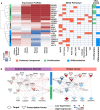Neurodevelopmental disorders and cancer networks share pathways, but differ in mechanisms, signaling strength, and outcome
- PMID: 37925498
- PMCID: PMC10625621
- DOI: 10.1038/s41525-023-00377-6
Neurodevelopmental disorders and cancer networks share pathways, but differ in mechanisms, signaling strength, and outcome
Abstract
Epidemiological studies suggest that individuals with neurodevelopmental disorders (NDDs) are more prone to develop certain types of cancer. Notably, however, the case statistics can be impacted by late discovery of cancer in individuals afflicted with NDDs, such as intellectual disorders, autism, and schizophrenia, which may bias the numbers. As to NDD-associated mutations, in most cases, they are germline while cancer mutations are sporadic, emerging during life. However, somatic mosaicism can spur NDDs, and cancer-related mutations can be germline. NDDs and cancer share proteins, pathways, and mutations. Here we ask (i) exactly which features they share, and (ii) how, despite their commonalities, they differ in clinical outcomes. To tackle these questions, we employed a statistical framework followed by network analysis. Our thorough exploration of the mutations, reconstructed disease-specific networks, pathways, and transcriptome levels and profiles of autism spectrum disorder (ASD) and cancers, point to signaling strength as the key factor: strong signaling promotes cell proliferation in cancer, and weaker (moderate) signaling impacts differentiation in ASD. Thus, we suggest that signaling strength, not activating mutations, can decide clinical outcome.
© 2023. The Author(s).
Conflict of interest statement
The authors declare no competing interests.
Figures





Similar articles
-
Comprehensive immunoprofiling of neurodevelopmental disorders suggests three distinct classes based on increased neurogenesis, Th-1 polarization or IL-1 signaling.Brain Behav Immun. 2024 Jan;115:505-516. doi: 10.1016/j.bbi.2023.11.013. Epub 2023 Nov 14. Brain Behav Immun. 2024. PMID: 37972879
-
How PTEN mutations degrade function at the membrane and life expectancy of carriers of mutations in the human brain.bioRxiv [Preprint]. 2023 Jan 27:2023.01.26.525746. doi: 10.1101/2023.01.26.525746. bioRxiv. 2023. Update in: J Mol Biol. 2023 Dec 15;435(24):168354. doi: 10.1016/j.jmb.2023.168354. PMID: 36747841 Free PMC article. Updated. Preprint.
-
Rare recurrent copy number variations in metabotropic glutamate receptor interacting genes in children with neurodevelopmental disorders.J Neurodev Disord. 2023 Apr 29;15(1):14. doi: 10.1186/s11689-023-09483-z. J Neurodev Disord. 2023. PMID: 37120522 Free PMC article.
-
Neurodevelopmental disorders, like cancer, are connected to impaired chromatin remodelers, PI3K/mTOR, and PAK1-regulated MAPK.Biophys Rev. 2023 Apr 1;15(2):163-181. doi: 10.1007/s12551-023-01054-9. eCollection 2023 Apr. Biophys Rev. 2023. PMID: 37124926 Free PMC article. Review.
-
Annual research review: The (epi)genetics of neurodevelopmental disorders in the era of whole-genome sequencing--unveiling the dark matter.J Child Psychol Psychiatry. 2015 Mar;56(3):278-95. doi: 10.1111/jcpp.12392. Epub 2015 Feb 11. J Child Psychol Psychiatry. 2015. PMID: 25677560 Review.
Cited by
-
Unveiling hidden connections in omics data via pyPARAGON: an integrative hybrid approach for disease network construction.Brief Bioinform. 2024 Jul 25;25(5):bbae399. doi: 10.1093/bib/bbae399. Brief Bioinform. 2024. PMID: 39163205 Free PMC article.
-
Molecular principles underlying aggressive cancers.Signal Transduct Target Ther. 2025 Feb 17;10(1):42. doi: 10.1038/s41392-025-02129-7. Signal Transduct Target Ther. 2025. PMID: 39956859 Free PMC article. Review.
-
Kinase signaling cascades: an updated mechanistic landscape.Chem Sci. 2025 Aug 19. doi: 10.1039/d5sc04657b. Online ahead of print. Chem Sci. 2025. PMID: 40880801 Free PMC article. Review.
-
Decoding Mechanisms of PTEN Missense Mutations in Cancer and Autism Spectrum Disorder using Interpretable Machine Learning Approaches.bioRxiv [Preprint]. 2025 Jan 21:2025.01.16.633473. doi: 10.1101/2025.01.16.633473. bioRxiv. 2025. PMID: 39896643 Free PMC article. Preprint.
-
Single cell spatial biology over developmental time can decipher pediatric brain pathologies.Neurobiol Dis. 2024 Sep;199:106597. doi: 10.1016/j.nbd.2024.106597. Epub 2024 Jul 9. Neurobiol Dis. 2024. PMID: 38992777 Free PMC article. Review.
References
Grants and funding
LinkOut - more resources
Full Text Sources
Research Materials

